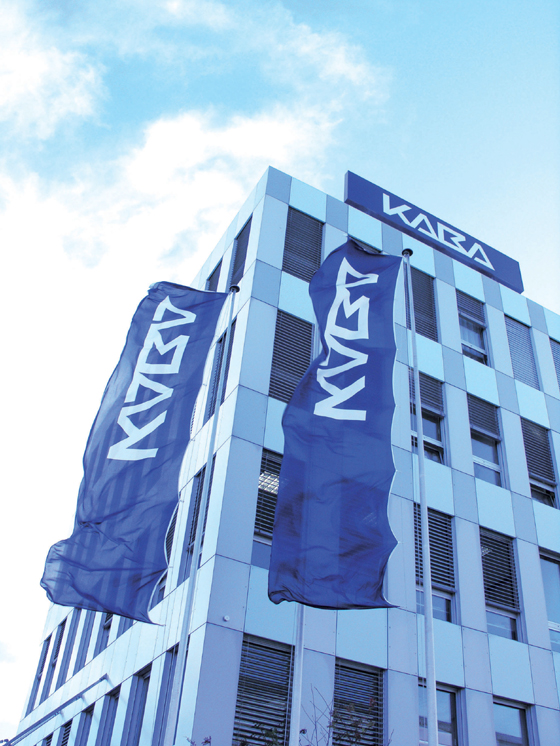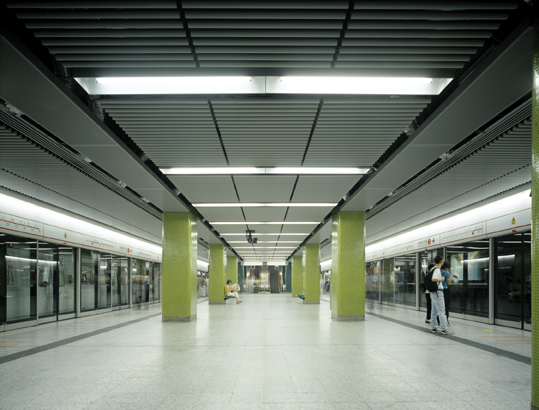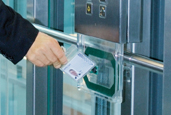In 1934, Kaba revolutionized locking technology with its new reversible key patent. In the 1960s, Kaba introduced the world¡¯s first mechanical pushbutton lock onto the market. And 2007 saw Kaba once again proving its technological leadership in the security industry with its new pioneering CardLink solution. There¡¯s tradition at Kaba -- in every respect.

A Tradition in Innovation
Over its history, stretching back more than 140 years, Kaba has often been a pioneer in the security business. Founded in 1862, the company has developed from being a local manufacturer of safes to a global player in the security industry -- thanks to forward-looking strategy, deft acquisitions and pioneering product innovation. In 2001, with the purchase of the American firm Unican, the Kaba Group became one of the world¡¯s leading providers in the security business. The acquisition of the Wah Yuet Group in China and CSS Inc. in America in 2006 consolidated this position and created a key basis for further expansion in the Asia Pacific growth region.
Technology Made in Switzerland
Today, the company is an important technology leader and expert provider of access control solutions for buildings, facilities and sites and of enterprise data collection systems. Around 9,000 staff in 60 countries help to ensure that the Kaba Group is able to convince its customers¡¯ time and again with innovative solutions perfectly suited to their needs.
Kaba is the technology leader for a wide range of security requirements. The company¡¯s impressive portfolio extends from security and automatic doors, through locks and systems for access control and time and enterprise data collection, to high-tech locking solutions for hotels and high-security locks. Other important pillars of the business are contactless identification and the production of key blanks and key production equipment. In all this, the Kaba Group meets the needs both of the lower and middle market segments and of the premium end of the market.
Solutions for the Future
When developing new technologies and products, the Kaba Group pays particular attention to the sustainability of its overall range. For about the last two decades, the company has pursued a ¡°Total Access¡± strategy. With ever more complex technology and constantly changing security requirements on the part of customers, the Group decided years ago that mechanical locking systems, electronic access control and door systems all needed to be seen as elements in an integrated overall system. This means that the individual components of the different solutions have to be compatible with each other -- a requirement which Kaba is able to meet thanks to its ¡°Total Access¡± strategy: Kaba products and systems not only offer guaranteed compatibility but can also be upgraded. Thus, as well as providing security, smoothness of organization and user convenience, products from the Kaba Group also offer medium and long-term investment security for its customers.
A Pioneer in the Marketplace
The Kaba Group has always been a pioneer rather than an imitator. The company is known for creating and tapping new markets with ground-breaking technologies. Thus, for instance, in 1934, when Kaba revolutionized locking technology with its new ¡°security lock involving a flat key with indentions on each side¡± -- its reversible key. The Kaba Group continues to offer innovative products and solutions which take onboard the requirements of a range of customer segments and implement these requirements in optimal fashion. Private individuals, service companies and industry, governments and institutions: they all rely on Kaba products. And with very good reason, as the following examples show.
|
 
|
|
|
|
Metro station in Hong Kong: Platform Screen Doors increase service frequency, help prevent accidents and enable a better and energy-efficient conditioning of the stations. (Photo by Kaba Group) |
|
|
Passenger Transport
In the Asia Pacific region in particular, platform screen doors for metro systems are much in demand. From Hong Kong, via Kaohsiung and Taipei, to Beijing (Olympic Line) and Shanghai, the Kaba Group installs Platform Screen Doors (PSDs) in major projects.
Platform screen doors perform a central function in passenger flows and enhance passenger comfort and safety as well service capacity. They separate the platform from the track, making for prevention of tragic accidents. Furthermore, this separation permits higher arrival and departure speeds for the trains, thus shortening the overall stop time and enabling service frequency to be increased significantly. The installation of platform screen doors also allows better air conditioning in the station. Full-height platform screen doors keep the pressure waves, heat and dust away from the platforms, creating a pleasant environment for passengers as well as having a positive impact on energy use in air conditioning.
The Kaba Group offers half-height and full-height platform screen doors, in standard or tailored design. The product range is rounded off with gap closers, as well as lighting and integrated advertising space. In addition to this comprehensive product range, the Group also provides counsel, project management, construction, installation and maintenance -- all from a single source.
|
 
|
|
|
Photo by Kaba Group |
|
Double Security
A combination of mechanical keys and cylinders remains the most widely used locking technology. This traditional solution is inexpensive, efficient and secure and therefore very popular with private individuals. Companies, however, demand electronic solutions which provide effective support for their operations through user-friendly integration of access control and management and the collection of enterprise data. As the world¡¯s first producer, the Kaba Group brings together the advantages of mechanical locking technology and of electronic access control into a single user-friendly locking system -- a mechatronic one.
Mechatronic products provide double security: only when the mechanical and electronic coding match can the door be opened. In addition, the keys, with their mechanical key bit, can be used in purely mechanical cylinders, while the electronic top of the key, with integrated Legic chip, can also be used with purely electronic components. This makes it possible to provide countless tailored variants of locking systems which permit almost unlimited flexibility in defining and altering access authorization.
However, the biggest advantage of mechatronic locking systems as against mechanical systems is surely this: that if a key is lost or stolen, it can be blocked immediately and very easily -- and without having to change the whole system. Thus, costs are reduced and at the same time security, smoothness of organization and user convenience are increased.
Contactless Identification
|

|
|
Smart Card: Integrated into just about any medium, the tiny Legic chip conveniently and securely covers virtually any operational need including contactless identification, organization, verification and cash-free payments. (Photo by Kaba Group) |
The Kaba Group is a distinguished provider of contactless smart card (13.56 MHz) technology. This technology centers around the tiny Legic chip, which can be integrated into almost all media. Incorporated into keys, staff badges or bracelets, it can be used to cover practically all operational requirements conveniently and securely. The variety of applications ranges from access control, time & attendance, parking, cashless payments (cafeterias or vending machines, for example), IT-access, e-tickets, etc. up to high-security biometrical applications and other market needs of the future. The integrated, uniform Legic technology platform is capable of handling the authorization management for up to 127 applications with a single identification credential.
Legic-based identification solutions can be used in both work and leisure environments. They are easily combined in tailor-made systems, meeting individual requirements and needs. The modular Legic-based system solutions can be assembled and upgraded at any time.
Characterized by structural flexibility and scalability, unique security features and superior application comfort, contactless identification is much in demand around the world: to date, around 70 million Legic chips and a million reader modules are in use.
Milestone in Access Control
In the area of access control, too, the Group is one step ahead with innovative solutions. One example is CardLink.
Modern access systems not only provide optimum security but also regulate the flow of people at a company. In the business world, online access systems have now become standard. But some companies do not want the expense of across-the-board installation and wiring. This is where Kaba¡¯s new CardLink technology comes in: it integrates the various electronically secured doors into a central authorization management system irrespective of whether they are wired (online) or not (stand-alone). For internal door locks, with CardLink individual authorization is stored on a badge and is read and verified at the access point.
CardLink combines the advantages of the previously separate worlds of stand-alone and online components and, by integrating them into a single technology, for the first time allows extremely flexible overall access management. The main difference as against current online systems is that the information is first entered in the central system; authorization to open doors is then assigned to the relevant badges and stored on them for a limited time.
|

|

|
|
Integrated authorization management: CardLink combines stand-alone and on line access control. Irrespective of whether the doors in a building are online (green = wired) or offline (orange = wired), they can all be opened using a single badge and may be managed centrally. (Photo by Kaba Group) |
Photo by Kaba Group |
Thus, the user carries the information on their badge to the locks which are not connected to the network. CardLink thereby allows both online and stand-alone components to be configured on the same user interface. In practical terms, this means that time-consuming tasks such as staff changes, the issuing of visitors¡¯ badges and handling of lost keys no longer have to be carried out twice, but can be dealt with in one go. Thus, CardLink technology brings convenience, flexibility and security at the highest level -- while at the same time allowing operating costs to be reduced.
For customers who wish to convert from mechanical to electronic access systems, this solution offers a particularly inexpensive and efficient way of doing so. Even if the site comprises several buildings, it is no longer necessary to wire them all up for integration into the electronic system, since the information as to whether someone has access to a particular room is stored on their badge.
A Key to Success
If a company is to be and to remain successful in the security industry, it is clearly of decisive importance to be at the forefront in the race for new technologies. But innovation is only half the story. In addition to state-of-the-art technology, customers also value the quality and sustainability of products as well as good counsel and reliable service and support -- this overall package marks out the Kaba Group as a reliable partner worldwide. Its long-standing customers trust in the security and the service which Kaba has always offered them. Retaining this trust is a challenge which the Kaba Group will continue to set itself, and to meet through innovation and top-class service.
Interview
|

Rudolf Weber, CEO of Kaba Group (Photo by Kaba Group) |
Total Access is Kaba¡¯s
single-source
implementation of this market requirement.
|
|
|
|
Kaba, with more than 145 years of passion in the security field, offers its customers tailor-made solutions that optimize their benefits in terms of security, organization and convenience, while at the same time maximizing the creation of value for all its stakeholders. Sunny Kim, Editor of SecurityWorld INTL talked about the Kabas strengths and next challenge in the interview with Rudolf Weber, CEO of Kaba Group.
Kaba adopts unique "Total Access" strategy, thus meeting its customers needs for security, organization and convenience at building and information access points. Please briefly explain about the strategy to our readers.
In the security business, there are two constant factors. Firstly, user habits are constantly changing. And secondly, electronics and electromechanical technologies are continuously being refined and play an ever larger part in the main components which regulate access to a modern building. That¡¯s why it is crucial to view mechanical locking systems, electronic access control and doors as part of one complete system and to design and execute them as such. Accordingly, interoperability of the respective components is required. Total Access is Kaba¡¯s single-source implementation of this market requirement.
In your opinion, what are Kabas strengths when it comes to security?
Kaba has been operating successfully in the security business for more than 145 years. The high quality standard of our products and the reliable service and support we provide are as highly valued by our customers as is sustainable product management. Through the Total Access strategy, we can offer compatibility of products and systems and almost unlimited upgrade potential.
Please tell us if there has been any notable achievement Kaba has made recently.
Well, our latest development, CardLink, has met with lively interest from our clientele. This innovative concept now allows stand-alone and online components to be incorporated into a single integrated system -- and without the need for additional wiring. Previously there have been two separate environments: one of online components and another of stand-alone components. We have now succeeded in bringing these two worlds together and thereby making full use of the advantages of both technologies. The resulting flexibility and user convenience are pioneering. All the functions of online technology -- the comprehensive management and control it enables -- are extended to the stand-alone components, which were previously a separate solution. Buildings, and whole building complexes, can now be provided with secure, managed and controlled access without the expense of wiring up all the doors.
Please briefly update us on some of the recent industry activities and developments that you think would have a significant impact on the security industry.
In terms of product technology, digitalization can be seen worldwide, i.e., there is a trend away from mechanical locking solutions towards mechatronic and digital locking systems. I also expect further consolidation in the market.
Security is much sought-after at the moment, not least because of the growing need for security in our society at large. Companies currently operating in the security business are benefiting from the current global situation. In my opinion, however, the key to success does not lie in the threatening situation we currently have. Only companies which are inventive and launch new products will be able to survive in the market.
What do you think is the next challenge facing you for further growth?
It goes without saying that we must and want to remain in a position where we can provide our customers with better products at more attractive prices than our competitors. Security has a lot to do with trust. We want to gain the trust of our customers and retain it for the long term.
For more information, please send your e-mails to swm@infothe.com.
¨Ï2007 www.SecurityWorldMag.com. All rights reserved.
|


